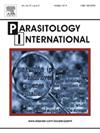具有树突附属物的粘虫一新种。
IF 1.5
4区 医学
Q3 PARASITOLOGY
引用次数: 0
摘要
粘虫属属于粘虫纲,是一个刺胞动物属,其特征是椭球状或圆形的粘孢子,具有位于前缝面的两个极性蒴果,通常没有尾部突出物。然而,在最近的黏液孢子研究中描述了不同的形态,表现出不同的附属物形式。本文报道了红食人鱼(Pygocentrus nattereri)中一新种粘虫的形态和分子特征。在amapap本文章由计算机程序翻译,如有差异,请以英文原文为准。
Myxobolus medusae n. sp., a new species of Myxozoa with dendritic appendages
The genus Myxobolus, belonging to the class Myxozoa, is a cnidarian genus characterized by ellipsoidal or rounded myxospores with two polar capsules located in the anterior sutural plane, commonly without caudal projections. However, diverse morphologies have been described in recent studies of myxospores, exhibiting various appendage forms. The present study describes the morphological and molecular characteristics of a new species of Myxobolus in the red piranha Pygocentrus nattereri. In 16 % (3/18) of the fish specimens captured in Lake Sacaizal, Amapá State, whitish cysts containing ovoid myxospores with dendritic caudal appendages were observed in the anterior chamber of the eye. The myxospores measured 17.7 μm long, 15.6 μm wide, and 14.0 μm thick and had two equally sized pyriform polar capsules 9.9 μm long and 4.2 μm wide. Phylogenetic analyses showed that the newly identified species, Myxobolus medusae n. sp., formed a clade with other species of Myxobolus without appendages and Henneguya, which infects Characiformes in Brazil, with a genetic distance above 12 %. These morphological and molecular data provide insights into a new species of the genus Myxobolus in P. nattereri, a fish species of socioeconomic importance in the Amazon region.
求助全文
通过发布文献求助,成功后即可免费获取论文全文。
去求助
来源期刊

Parasitology International
医学-寄生虫学
CiteScore
4.00
自引率
10.50%
发文量
140
审稿时长
61 days
期刊介绍:
Parasitology International provides a medium for rapid, carefully reviewed publications in the field of human and animal parasitology. Original papers, rapid communications, and original case reports from all geographical areas and covering all parasitological disciplines, including structure, immunology, cell biology, biochemistry, molecular biology, and systematics, may be submitted. Reviews on recent developments are invited regularly, but suggestions in this respect are welcome. Letters to the Editor commenting on any aspect of the Journal are also welcome.
 求助内容:
求助内容: 应助结果提醒方式:
应助结果提醒方式:


